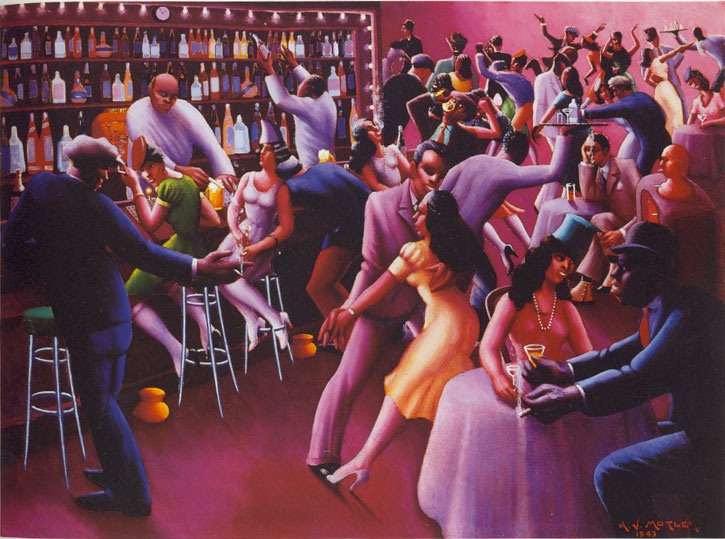Alyssa's Harlem Renaissance Art Page
The Importance of Art during the Harlem Renaissance
The Life of Archibald Motley Jr.
The Importance of Art during the Harlem Renaissance
Art played an essential part during the Harlem Renaissance. Blacks were expected to scrub floors and open doors, not to paint and express themselves (Edwards). Artworks painted or sculpted by black artists were excluded from museums, and hardly recognized by those who purchased art or were patrons. When the William E. Harmon Foundation arose in 1922, blacks were given the same artistic opportunity as whites. The Harmon Foundation was composed of exhibitions, prizes, and scholarships for blacks. Blacks were neglected in the art world before the Harmon Foundation. Under the Harlem Foundation, blacks emerged for the first time in numbers. They never formally organized a group, although it was publicly known that black artists were given great opportunities. As a group, the Harlem Renaissance artists were not distinguished by one theory or perspective regarding their art. All in all, the Harlem Renaissance spread to major cities and its exhibitions of individual artists in local organizations created a loose amalgram of unprecedented black artists (Cambell39).
For the first time, through artistic expression, blacks relinquished their oppression as individuals and expressed themselves freely during the Harlem Renaissance. Explaining his feelings on the Harmon Foundation, a Rutgers University Historian, Clement A. Rose states, "The glory of this show, is it demonstrates through these extraordinary pieces that blacks had a lot of things on their minds as artists in the 1920's and 30's, at a time which the country, for the most part, prepared to only hear a very constrained or simplified, or one-dimensional voice from blacks"(Edwards). The vitality of the arts during the Harlem Renaissance was displayed because black rights were expanded through their newly found freedoms to paint and sculpt.
The Harmon Foundation soon dissolved along with all of its collections of blacks' works. The Newark Museum later retrieved and displayed works by black artists that were exhibited in the Harmon Foundation, which marked the first time in history that an official museum accepted works by black artists. Through their art, African Americans attempted to show society that they were just as skilled as the white artists were, in every respect. The importance of art during the Harlem Renaissance was also exemplified through the fact that the image of the black woman or man transformed. The art displayed a separation from previous stereotypes of blacks appearing in art as "bug-eyed minstrels" and "shuffling darkies." Art during the Harlem Renaissance sparked a demise of stereotypes firmly fixed in the national conscious.
Although many biased whites made efforts to keep blacks out of the world of art, intellectual artists accepted blacks because world renown artists, Pablo Picasso and Henri Matisse, had used African themes in their art. Their art was often composed of tribal themes and primitive motifs, which influenced others in thinking that black artists should have just as much recognition. Art helped tear apart racist viewpoints toward blacks' expression. The talent in black artists during the Harlem Renaissance helped separate racial boundaries in the art world and stood as a basis for the abolishment of legal segregation.

Archibald Motley Jr., born in New Orleans in 1891, moved to Chicago as an adolescent where he worked as a laborer. In his 20's, becoming an artist was another career choice for Motley. He then considered that European study was a necessity for any aspiring artist to ever achieve success. Motley began to experiment with painting and acquired a taste for flashy colored and fun paintings portraying life in the urban areas in
which he lived. In 1924, when the Harlem Renaissance transformed into an ear filled with more positive images, searching for outstanding roles models who used sympathetic characterizations in their art, Archibald Motley Jr. was the quintessential artist. His painting, Mending Socks portrayed a compassionate image of an elderly woman who was simply mending her socks. This painting perfectly fit under the description Harlem Renaissance art, and introduced Motley as an official Harlem Renaissance artist. In 1925, Motley won the Francis Logan Medal from the Art Institute of Chicago for his painting, A Mulatress. In 1928, Motley held a one-man exhibition at the Ainslee Galleries in New York (Cambell171-174). In 1929, Motley won a Guggenheim Fellowship that allowed him to study in Paris for a year (Powell173). In the late 20's, Motley won a Harmon Foundation award for Old Snuff Dipper, which exhibited the realistic style that he had used in his early career. In 1933, Archibald Motley Jr., was included in an Art Institute of Chicago exhibition that was in conjunction with "A Century of Progress International Exposition" (Powell175).
Motley never made efforts to glorify or idealize the activities of his subjects. He would
rather depict his people as he saw them in their urban, Harlem setting of the 1920's. Motley's "people-filled" cityscapes were incongruous with the racial identification of the Harlem Renaissance and more in accord with the concepts of the Ashcan School.

The Ashcan School was a group of American artists and journalists who regarded their themes as ordinary people involved in ordinary activities. Motley's joyous and activity-filled compositions reflected a spiritual side of life during a period of intense cultural activity and heightened ethnic awareness. His works are a reminder to have good cheer and to dwell on the brighter side of life.
